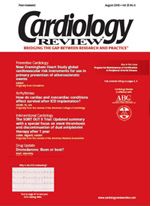Publication
Article
Cardiology Review® Online
The safety of PDE5 inhibitors in ED treatment: Putting cardiovascular concerns to rest
Erectile dysfunction (ED) is a problem that affects over 50% of men at some point during their lifetime and becomes increasingly problematic with age. For decades, the only oral treatments physicians could prescribe for ED were complementary medications; however, there was scant scientific evidence to support the effectiveness of these medications. In addition to these treatments, urologists offered treatment with penile vacuum pumps, penile injections, or surgery with the implantation of a rigid or flexible penile prosthesis or inflatable penile prosthesis. With the advent of phosphodiesterase-5 (PDE5) inhibitors, which were first introduced in 1978 with sildenafil (Viagra) followed by vardenafil (Levitra) and tadalafil (Cialis), the diagnosis and treatment of ED changed dramatically.
PDE5 inhibitors have shown efficacy in approximately 70% of the patients to whom they are prescribed. Over 80 million prescriptions for these drugs have been written since 2000. Prior to the introduction of PDE5 inhibitors, many men were reluctant to discuss the treatment of ED with their family, their friends, and even their physicians. As a result of the extensive press coverage and marketing blitz that accompanied the introduction and widespread use of PDE5 inhibitors, more men now come to physicians’ offices seeking treatment for ED. Others, however, remain hesitant to try this new class of drugs. Both patients and their spouses are concerned that PDE5 inhibitors will cause serious cardiovascular adverse effects, such as angina, myocardial infarction (MI), and death. In addition, many primary care physicians and cardiologists have concerns about the safety of PDE5 inhibitors.
In his article, Cheitlin (page 18) has put to rest many of the cardiovascular concerns shared by patients, their families, and physicians. Cheitlin states that the incidence of acute MI in patients taking PDE5 inhibitors is no different than that in placebo controls. He explains further that patients with coronary artery disease and other cardiovascular problems who take PDE5 inhibitors experience, at the most, a very minor decrease in their blood pressure. This minor blood pressure reduction has not been shown to precipitate any significant myocardial ischemia, infarctions, or arrhythmias. Cheitlin also found no evidence that men who took PDE5 inhibitors in combination with multiple antihypertensive medications experienced a significant decrease in blood pressure.
Recently, the Food and Drug Administration (FDA) has removed the cautions it had placed on the combination of PDE5 inhibitors with certain alpha-blocking medications. Therefore, there are only two remaining groups for which the use of PDE5 inhibitors is contraindicated—patients taking nitroglycerin and those who are too ill to engage in sexual intercourse.
Now that the relative safety of PDE5 inhibitors is being recognized, these drugs have become an excellent addition to the armamentarium of
primary care physicians and urologists. Another benefit of the increase in patients seeking treatment for ED that has accompanied the introduction of PDE5 inhibitors is that certain un-
derlying causes of ED, such as arteriosclerosis and diabetes, are being
recognized and treated before they become serious.
To add a cautionary note, during the past few months there have been reports that the FDA is investigating 42 incidents of sudden partial or total blindness in men taking PDE5 inhibitors. These incidents have been attributed to nonarteritic ischemic op- tic neuropathy (NAION), a rare condition that can cause partial loss
of vision and even total blindness. Although some PDE5 inhibitors have been associated to some degree with minor visual disturbances since their initial studies, the reports of these 42 cases of NAION are new. Furthermore, the relatively small number of men who have experienced these serious symptoms need to be viewed in
the context of the 28 million men
who have used or are currently using PDE5 inhibitors. In addition, men who have experienced this sudden partial or total blindness appear to have significant comorbidities, such as diabetes, high blood pressure, and high cholesterol. The comorbidities may have been responsible for the onset of NAION, rather than the use of PDE5 inhibitors. This obviously is an issue that bears watching. But in light of the general safety of these medications as reported by Cheitlin, it is unlikely to significantly affect the ability of physicians to prescribe PDE5 inhibitors to successfully treat a large percentage of men with ED.
